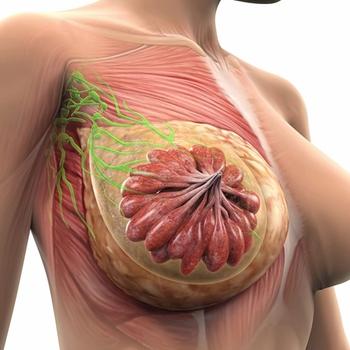
Targeted Axillary Dissection Improves False Negative Rates for Residual Nodal Disease
Targeted axillary dissection improves axillary staging and pathologic evaluation of residual nodal involvement after chemotherapy in node-positive breast cancer.
Targeted axillary dissection (TAD) improves axillary staging and pathologic evaluation of residual nodal involvement after chemotherapy in node-positive breast cancer, reported Henry M. Kuerer, MD, PhD, CMQ, of the MD Anderson Cancer Center in Houston, Texas, at the 33rd Annual Miami Breast Cancer Conference, held March 10–13 in Miami Beach, Florida.[1]
TAD involves marking biopsy-confirmed metastatic sentinel lymph nodes (SLNs) with clips so that selected nodes can be removed after neoadjuvant chemotherapy for pathologic evaluation of residual nodal involvement. It is an alternative to complete axillary lymph node dissection (ALND), which increases the risk of lymphedema, and traditional SLN dissection (SLND), which can miss residual disease.
“Ensuring removal of the node with biopsy-proven metastatic disease after [neoadjuvant chemotherapy] is a more accurate method to stage the axilla compared with SLN alone,” Dr. Kuerer reported. “Outcome studies of TAD alone among patients with nodal [pathologic complete response] are underway.”
To determine whether or not identification and removal of the clipped node with biopsy-proven metastasis prior to chemotherapy improves the accuracy of SLND after preoperative chemotherapy, Dr. Kuerer and colleagues
“We found that placing a radioactive [I125] seed 1 to 5 days within the lymph node helped us to remove it,” he said. The seeds do not interfere with Tc-99m lymphoscintigraphy, he noted.
The clipped nodes were not retrieved as SLNs in 23% of cases, but this was unrelated to the presence or absence of residual disease, he reported. TAD followed by ALND identified a false negative rate (missed residual disease) of just 2%, compared to 10.1% in patients undergoing SLND and ALND without TAD.
References:
1. Caudle AS, Yang WT, Krishnamurthy S , et al. Improved Axillary Evaluation Following Neoadjuvant Therapy for Patients With Node-Positive Breast Cancer Using Selective Evaluation of Clipped Nodes: Implementation of Targeted Axillary Dissection. J Clin Oncol. 2016 Jan 25. [Epub ahead of print]
Newsletter
Stay up to date on recent advances in the multidisciplinary approach to cancer.

















































































